We’ve all played hockey in tough conditions. There are the rinks where fog makes it almost impossible to see or the boards look like they’ll fall over if you touch them. Some rinks are swimming pools after the Zamboni finishes or need to be patched up like a polo field. Or if it’s not the rink, it’s us – out of shape, lungs burning and gasping for air.
But few of us can say they’ve experienced all of the above in an event rightfully named “Hockey Goes Higher” where The Hockey Foundation literally skated among the clouds, surrounded by the Himalayan Mountains at 4,361 meters – a certified Guinness World Record.
Building a Foundation for Hockey in India
In India, cricket and field hockey dominate the landscape. But in the Ladakh region within the state of Jammu and Kashmir in northern India, it is ice hockey that reigns supreme.
“I clearly remember my first time getting to India, getting to Ladakh and seeing the kids on the ice already,” recalled The Hockey Foundation’s founder and executive director Adam Sherlip from his first coaching trip to the region in early 2009. “Hockey was there before [the Hockey Foundation] ever went, and before I ever went. It was much smaller at the time and you see them using a bent branch off of a tree and a rock as a stick and puck. I just immediately fell in love with the fact that they would do anything [to play hockey].”
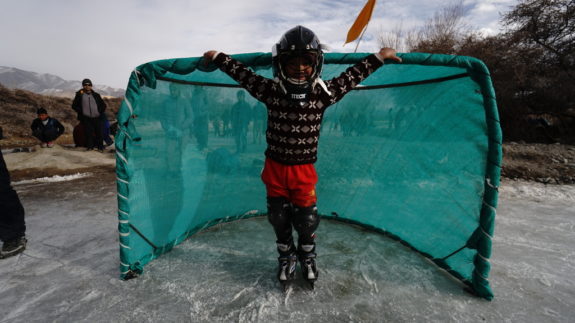
Sherlip, who would coach India’s first national men’s ice hockey team, created The Hockey Foundation after that initial trip. Since it’s inception, the volunteer-driven organization has donated equipment, uniforms, coaching staffs, and books to programs around the world.
“Our global mission is to empower under-served youth, promote social change, peace, and prosperity, and support community development through hockey,” emphasized Sherlip, who previously coached in China with the New York Islanders organization. “We’ve donated equipment to programs around the world [including Chile, Kenya Morocco, Egypt, an Inuit village in Northern Quebec and the Bronx, NY], but that’s not our end-goal. The more we can get into communities to provide coaching support, the more we can make an impact like we’ve made in Ladakh: changing the landscape of hockey in the region with an emphasis on long-term sustainability, growth, and self-sufficiency.”
How High Can You Go?
In 2014, one of The Hockey Foundation’s coaches brought up the idea of trying to set a Guinness World Record for the highest altitude game. The task was not an easy one, there was a catch. Today games are regularly played in Leh, a major city in Ladakh and the epicenter of hockey in the region at 3,500 meters. In order to get the record, Guinness wanted the foundation to go even higher.
Welcome to the remote village of Chibra Kargyam, located approximately five hours from Leh and high in the Himalayas.
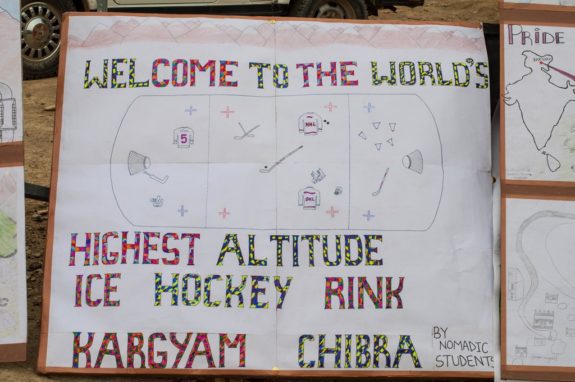
“Even in Leh … it’s really difficult to walk uphill, let alone play hockey,” noted Sherlip. “[It’s] like playing in Denver sitting atop another Denver (Denver is 5,280ft/1609m). Our event was two Denver’s plus Calgary (Calgary is 1049m/3,441ft) with room to spare.”
As former NHL referee Mike Leggo, who officiated the game, recounted, “the lack of oxygen for the officials was a challenge although not as bad as the players experienced because they were doing short intense bursts while we were more in constant motion. I did have to take a few moments and catch my breath at play stoppages with my hands on my knees gasping for breath just like after an intense stretch of play in the NHL.”
The (Thin) Air Up There
While the air at higher altitudes has less oxygen compared to most of the world, and definitely something most participants were not used to, the setting was spectacular.
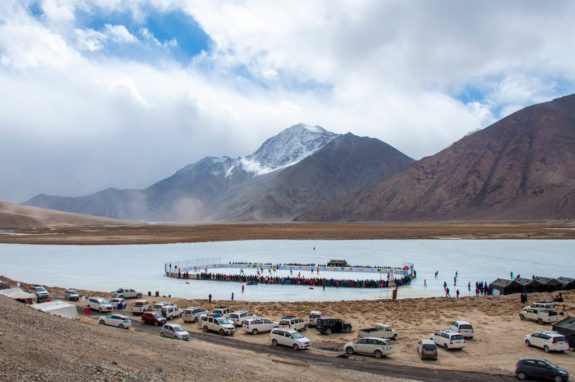
But a remote location does have its challenges and the demands from Guinness to qualify as a record had to be met. Requirements included referees, three 20-minute periods with stop time, eyewitness accounts, video footage and international-regulation boards – something not readily available in India.
“The boards were supposed to arrive [from Austria] in Ladakh in early January, [but] they didn’t arrive until 4-5 days before the event,” Sherlip said in regards to the Olympic-sized boards that eventually needed India’s military to help transport to their final destination.
“We’d sent over a rink specialist that’s a part of our team in January, and he spent a month freaking out about not being able to build the rink in time for the game and that the ice would be terrible … [Despite the short time frame] he was able to not only get the boards up and place all the dasher stickers, but also put the lines and dots on the ice to the best of his ability, and gave us a relatively smooth surface to play on.”
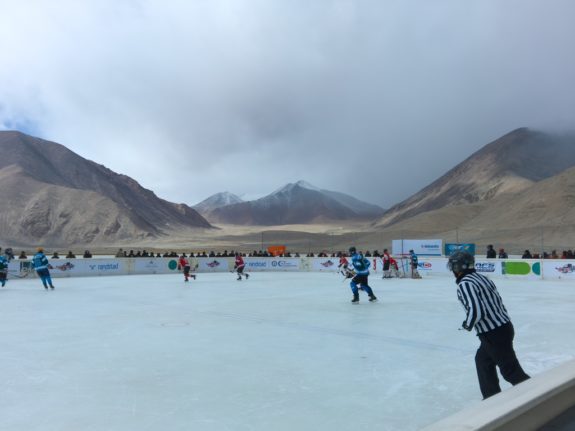
For Sherlip and his foundation, the boards were not only critical for the record but for the people of Leh and the arena they’ve been trying to build for over 10 years.
“The boards were a centerpiece for this event. Once this arena is completed and functioning, the hockey season will go from under two months to at least 3-4 months,” he said, stressing the main mission for the “Hockey Goes Higher” event was to support Ladakh and hockey around the globe. “[This arena] will require management, maintenance, coaching, and equipment, which means jobs will become available in hockey where they weren’t before. That’s a truly life-changing impact in the region that we’re excited about.”
Skating in the Himalayas
After everything had been planned and the rink was set up and ready to go, it was time to hit the ice. But as everyone knows, the conditions in the Himalayas are anything but predictable.
“The weather was terrible that day [in February]. It was actually one of the worst days of the entire trip. It was really cloudy and windy and cold,” recalled Sherlip.
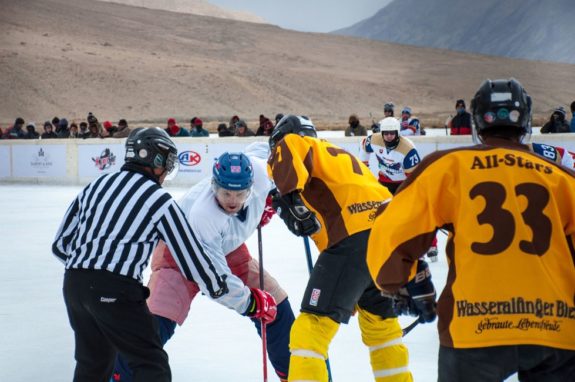
And while you’d think the temperature high in the mountains would be perfect, the ice was anything but ideal.
“It’s tough of course since there are no Zambonis and the sun is so strong while the air is cold,” said Sherlip who suited up for the game despite being sick. “We played on a frozen river, and the ice is frozen pretty well, but it’s constantly melting on top, and breaking off in chunks. Thankfully there weren’t the two-inch thick cracks that ran the course of the rink like we’re used to in Leh (lower altitude and on an irrigation pond), but there were definitely people who fell because of ice conditions.”
THF – Period 1 Guiness Game: https://t.co/yXOTQz31Gq via @YouTube
— Hockey Foundation (@HockeyFndtn) March 16, 2018
In the end, nothing could stop the game or deter the 40 skaters who suited up to making history. The Hockey Foundation’s team won 6-2 against Team Ladakh and “Hockey Goes Higher” was a huge success. Writer Ronnie Shukar, who scored the first goal of the game and now holds the record for the first-ever, highest-altitude goal, documented the event for Slate.com. It was obvious from his writing how special the event was. He wrote:
Hockey in the Himalayas. I couldn’t help but smile.
Hockey Does Go Higher
Playing hockey on the frozen ponds of Canada and the United States always has its challenges. Playing hockey – a regulation game nonetheless – on a frozen sheet of water in the Himalayan Mountains had its own obstacles to overcome as well. But in the end, the event left a lasting mark on the people of Ladakh and on everyone who was involved.
“Although it was difficult physically it was so enjoyable to be part of the experience,” Leggo said looking back on what was also his first-ever trip to India. “I was eager to help establish the Guinness World Record in order to raise attention for The Hockey Foundation as I believe strongly in their mission and goals.
Operating officiating clinics, increasing awareness, building the game and officiating programs across the globe is a lofty and worthwhile goal and I am eager to help the wonderful people at The Hockey Foundation in the future in any way I can … I never contemplated participating in a hockey event in such a remote and wonderful location. It was truly amazing and a fantastic experience.”
As Shukar wrote, the experience brought people together from all walks of life. “For all of us, the twain had met on a remote icy flood plain somewhere in nowhere northern India,” he said. “We came away teammates, opponents, friends, record-setters.”
Period 3 – THF vs Ladakh – Hockey Goes Higher: https://t.co/la4Qa6LgwA via @YouTube
— Hockey Foundation (@HockeyFndtn) March 31, 2018
Now with the certification in hand and the Guinness World Record to their name, Sherlip and The Hockey Foundation are already looking for what’s next.
“I’ve been so consumed by this project, and by all of the work I have to do with The Hockey Foundation, that I haven’t really had a chance to sit back and enjoy the record … I’m sure one day I’ll be able to truly appreciate the accomplishment.
“We don’t intend to stay in Ladakh or India forever. The program’s maturing every year and getting closer and closer to not needing the support of The Hockey Foundation. We’re looking into more communities and countries to support.”